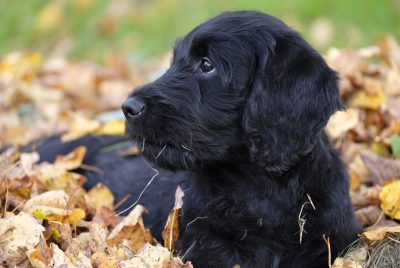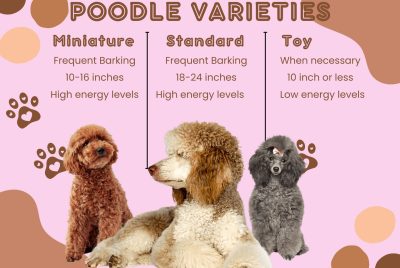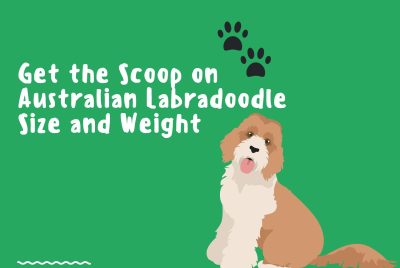What is an F1 Labradoodle
1The Labradoodle is a popular hybrid dog breed that has gained a lot of attention and popularity over the past few decades. Wondering, what is an F1 Labradoodle?
This mixed breed originated in Australia and was first bred in the 1980s by dog breeder Wally Conron. Conron’s goal was to develop a guide dog that had the friendly temperament of the Labrador Retriever along with the hypoallergenic coat of the Poodle.
The result was a dog with a great combination of traits from both parent breeds. As the Labradoodle increased in popularity as a family dog, subsequent generations were bred.
The term “F1” refers specifically to the first gen Labradoodle, a direct cross between a purebred Labrador Retriever and a purebred Poodle.
In this article, we will examine what defines an F1 Labradoodle. We will explore their origins, physical traits, temperament, trainability, and other considerations for this Labradoodle generation.
A comparison will be made between different Labradoodle generations, such as the F1B, F2, F2B, and Multigen dogs. By the end, you should understand what sets the F1 Labradoodle apart from other Labradoodle crosses.
Background on the Origin of Labradoodles
To understand the F1 Labradoodle, we have to start initially with the original purpose and motivations behind developing this breed. The Labradoodle was first bred in 1989 by Wally Conron, a breeding manager at the Royal Guide Dogs Association of Australia.
Conron was conducting early experiments in crossbreeding to develop a guide dog that did not shed. At the time, many people needed guide dogs but were allergic to dog hair and dander.
Conron decided to crossbreed a Labrador Retriever with a Standard Poodle, aiming to achieve a dog with the Lab’s famous temperament yet with the hypoallergenic coat of the Poodle.
It took over 30 attempts before Conron achieved his goal with a litter of three puppies that did not shed their coats. He named the crossbreed the “Labradoodle” and placed the successful puppies into guide dog training.
The early Labradoodles excelled at their work and provided a breakthrough for people needing allergy-friendly guide dogs. As word spread about this new hybrid dog, the Labradoodle quickly grew in popularity beyond just show dog work.
They developed a reputation as docile, friendly dogs that were also low-shedding and better tolerated by families with allergies.
Generations of Labradoodle Breeding
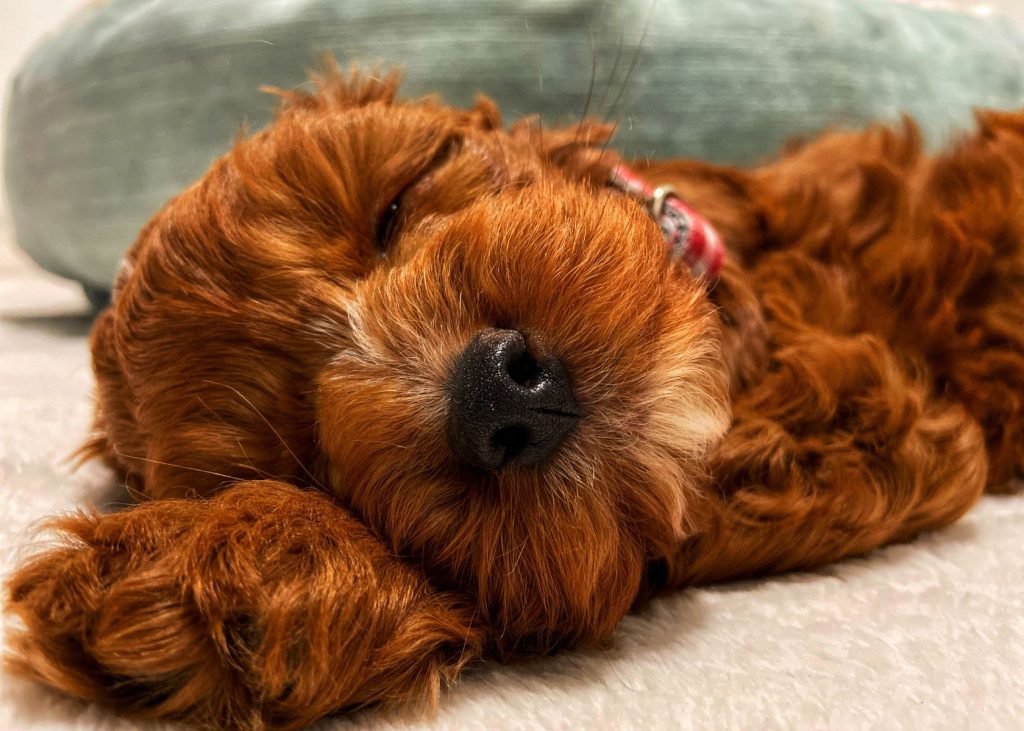
That original Labradoodle crossbred by Conron produced the first generation of Labradoodles, the F1 or first filial generation. This F1 dog is a direct cross between a purebred Labrador Retriever and a purebred Poodle, with a genetic makeup of 50% of each parent breed.
Once F1 Labradoodles began being bred together, this produced a new cross known as the F2 or second filial generation Labradoodle.
F2 dogs have 25% Labrador Retriever and 75% Poodle lineage. Breeding trends continued on, creating an alphabet soup of different Labradoodle generations!
Here is an overview of how the different Labradoodle generations are classified:
- F1 – The 1st gen labradoodle is a cross between a purebred Labrador Retriever and a purebred Poodle. This is a 50/50 cross.
- F1B – The “B” stands for backcross. This is an F1 Labradoodle crossed back to a purebred Poodle. The result is a dog with 75% Poodle lineage.
- F2 – The second filial generation, produced by breeding two F1 Labradoodles together. This produces a 75% Poodle and 25% Labrador Retriever mix.
- F2B – F2 Labradoodle backcrossed with a purebred Poodle. This results in a dog that is 87.5% Poodle.
- F3 – The third generation, two F2 Labradoodles bred together. This is an 87.5% Poodle and 12.5% Labrador Retriever cross.
- Multigen – Breeding two multigenerational Labradoodles together. The exact breed lineage will vary.
As you can see, the Poodle increases with each successive generation while the Labrador percentage decreases. There are ongoing debates about which generation makes the best combination.
However, the original 50/50 F1 cross continues to be prized by many for its balance of Lab and Poodle traits.
Traits and Attributes of F1 Labradoodles
Now that we understand how the different Labradoodle generations are bred, what makes the F1 cross so special? Why does this first generation pique the interest of potential dog owners and breeders?
The main appeal of the F1 Labradoodle is it represents the original vision for this hybrid breed – an equal mix of Labrador and Poodle traits. These dogs capture what is best about both parent breeds in one canine package!
Here are some of the key attributes associated with F1 Labradoodles.
Physical Appearance
- Medium-large size, typically 50-65 lbs for males and 40-55 lbs for females
- An athletic, solid body that is not too bulky or lanky
- Head shape is often a blend of the Lab and Poodle
- F1 coats can vary widely, from straight to loose curls. The texture is soft but dense.
- Standard coat colors include black, chocolate, yellow, cream, apricot, gold, red, silver, parti, and phantom variations.
Temperament
- Friendly, affectionate, happy demeanor reminiscent of the Lab
- Eager to please, highly intuitive, and responds well to training
- Moderate to high energy levels and playfulness
- Does excellent with children and as a family companion
- More outgoing and engaging than some Poodle crosses
Trainability
- Intelligence and willingness to work from the Poodle
- Aims to please their people like the Labrador
- F1 Labradoodles are highly trainable and pick up new skills quickly
- They excel at obedience, agility, retrieval, scent work, and more
- Early socialization and training are recommended to nurture the best behavior
Allergy-Friendliness
- The F1 coat is low-to-non shedding with less dander
- Great match for families with mild dog allergies
- Important to note every dog is different in allergen production
- Should still meet the puppy’s parents when assessing allergies
Lifespan and Health
- Expected lifespan of 10-14 years
- Hybrid vigor gives them an advantage over purebred dogs
- Prone to issues like hip and elbow dysplasia, eye disease, ear infections
- Responsible health testing of parents helps lower the risk
As you can see, the F1 beautifully blends the best traits from both the Poodle and Labrador source breeds. These dogs are people-oriented, highly trainable, and have low shedding – making them a versatile hybrid suitable for many owners.
Finding an F1 Labradoodle Puppy
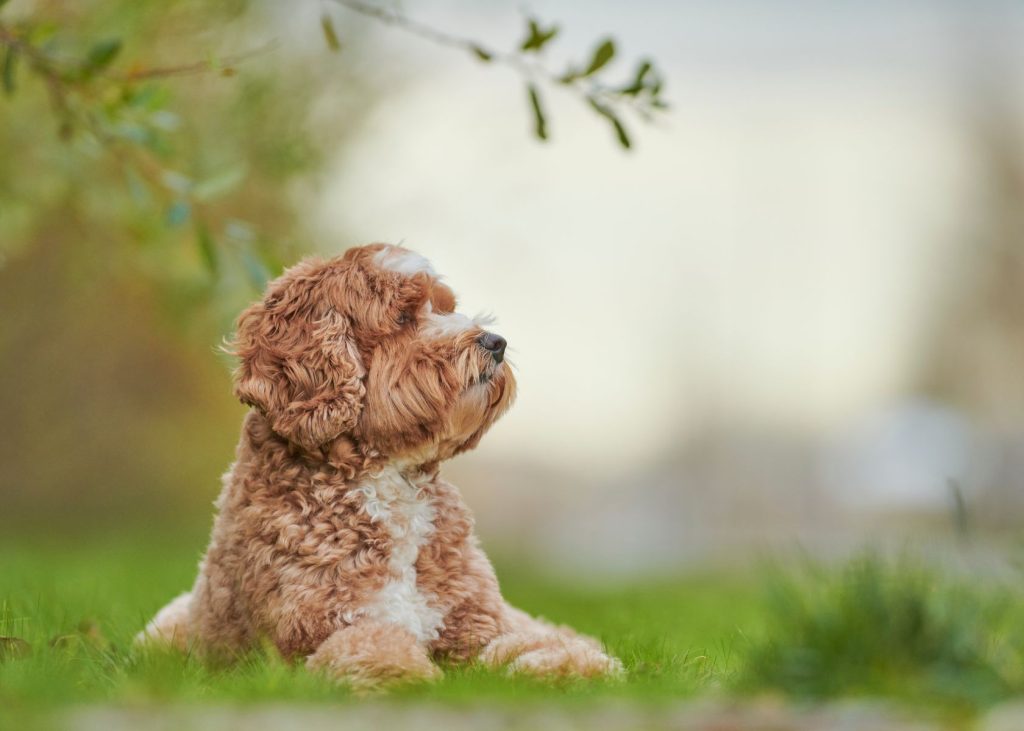
Given the rise in popularity of Labradoodles over the past couple of decades, finding a litter of F1 puppies may seem easy. However, ensure your pup truly comes from health-tested, purebred parents. Talk to any potential breeders about the following:
Availability and Cost
- F1 litters are less common than multigen crosses, but they are still readily available
- Expect to pay $2000 to $3500 for an F1 Labradoodle puppy from a quality breeder
- Beware of unusually low prices, as that may indicate unhealthy breeding practices
Parent Dogs
- Ask to see pedigrees, health clearances, and pictures of the parents
- Both parents should be purebred – Labrador Retriever and Poodle
- A breeder should prove lineage if claiming puppies are F1
Health and Temperament
- Vital that the breeder properly health tests both parent dogs
- Hip/elbow, eye, DNA, and cardiac exams help lower risk of issues
- Parent dogs should exhibit excellent temperaments and be socialized
- Look for breeders who culture puppies in a family environment
Coat Color
- F1 litters display a variety of possible colors from both parent breeds
- Color does not affect the puppy’s health or temperament in any way
- Choose your favorite shade, but don’t pay extra for rare colors
- Temperament, health, and breeder reputation are most important
Take your time researching breeders thoroughly. An ethical, responsible breeder who health tests and cares about bettering the breed is always worth waiting for. Never settle for anything less when it comes to your F1 Labradoodle puppy.
Considerations for Owning a 1st Generation Labradoodle
While F1 Labradoodles make outstanding companions, they require effort and preparation for their needs. Here are some key considerations:
Grooming
- F1 coats require regular brushing and combing, usually every other day
- Most will need professional grooming every 6-8 weeks
- Clipped fur should be 1-2 inches to avoid matting and maintain curls
Training
- Early socialization and training is strongly advised
- Can excel in many canine sports – agility, dock diving, therapy work
- Respond extremely well to positive reinforcement training methods
- Mental stimulation is just as important as physical exercise
Health
- Prone to hip and elbow dysplasia, eye disorders, allergies
- Responsible breeders screen parents to lower the risk
- There is a higher occurrence of health issues than some Poodle crosses
- Pet insurance is recommended, given the potential vet costs
Lifestyle Adaptability
- Moderate to high energy – daily walks and playtime a must
- Can thrive in urban or rural settings
- Need both mental and physical exercise daily
- Will be your constant companion – not suited for being left alone
The ideal home for an F1 Labradoodle is an active family with time to train, exercise, and groom these beautiful hybrids. When cared for properly, the F1 Labradoodle will return the love with loyalty, laughter, and years of unforgettable memories.
Differences Between F1 and Other Labradoodle Generations
While we’ve covered the many merits of the F1 Labradoodle so far, it’s also helpful to understand how they compare and contrast to other generations. What are the main differences in the appearance, behavior, and allergy-friendliness of the F1 versus other crosses?
Here is a breakdown of how the F1 stands apart from some other popular Labradoodle generations:
F1 vs F1B
- F1 is 50% Poodle, 50% Lab. Fb1 is 75% Poodle, 25% Lab
- F1B has a more uniform curl coat with increased shedding allergy friendliness
- F1 tends to have a denser coat with stronger water resistance
- F1 usually has more of the Labrador temperament and energy level
F2 vs F1
- F1 is 50% Poodle, 50% Lab. F2 is 25% Lab, 75% Poodle.
- F2 coat is tighter curls, extremely low shedding
- F1 is often larger in size closer to a Lab, F2 more in the Poodle range
- F1 shows more trainability, people-focus, and retrieving instincts
F1 vs F2B
- F2B is 87.5% Poodle, just 12.5% Labrador Retriever
- F2B have the tightest curls and are the most hypoallergenic
- F1 is larger, with more solid body mass and athleticism
- The F1 temperament exhibits more Lab influence in playfulness
F1 vs F3
- F3 is 87.5% Poodle lineage from 2 F2 parents
- F3 coats are super non-shedding and allergy-friendly
- F1 has a slightly denser coat with more water resistance
- F1 tends to retain stronger Lab traits in trainability and temperament
Multigen vs F1
- Multigen have a wide range of Poodle/Lab lineage depending on parents
- Multigen coats vary a lot – some low shedders, some are not
- F1 offers the original 50/50 hybrid split between the two breeds
- F1 temperament shows a more balanced blend of traits from both parents
While every dog is unique, these comparisons demonstrate the significant differences that can exist between Labradoodle generations. Many families continue to prefer the F1 for its even blending of Poodle/Lab traits in coat, size, looks, and personality.
Frequently Asked Questions About F1 Labradoodles
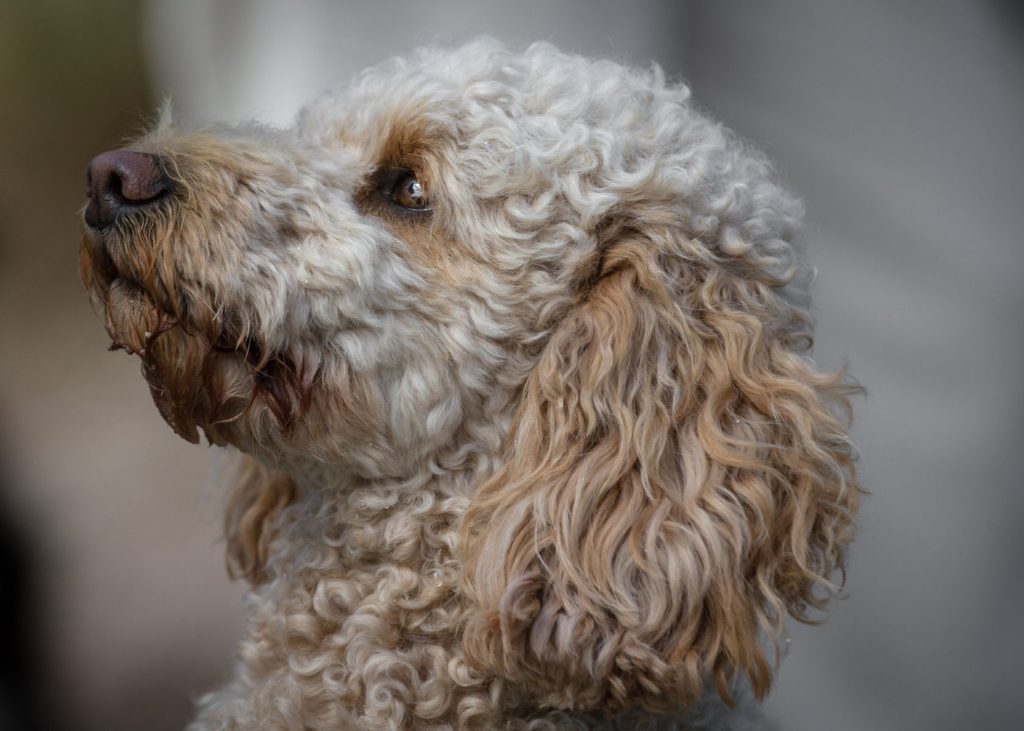
Given the complex alphabet soup of Labradoodle generations, it’s very common for potential owners to have lots of questions about the F1 specifically. Here are answers to some of the most frequently asked questions:
Are all F1 coats the same texture?
F1 coats can vary quite a bit, even within the same litter. Some are straight, some wavy, and some have loose curls. The texture can be affected by which Poodle was used in the cross. Overall, the coat will be soft yet dense and fuller than a purebred Poodle’s coat.
What size are full grown F1 labradoodle?
Most F1 Labradoodles reach 50-65 lbs for males and 40-55 lbs for females. This makes them medium-large dogs. Size depends partly on whether a Standard or Miniature Poodle was used for breeding.
Do F1 Labradoodles shed?
While F1 dogs are low-to-non-shedders, they are not 100% non-shedding. They are less allergenic than a Labrador but may not be a perfect match for severe dog allergies. Every dog varies in dander production.
Are F1 Labradoodles good family pets?
Yes, F1 Labradoodles tend to make exceptional family companions. They are affectionate, patient with children, highly trainable, and love being involved in family activities. Proper socialization is vital.
How much exercise does an F1 Labradoodle need?
F1 Labradoodles have moderate-high exercise needs, typically 30-60 minutes per day. They love activities like walking, jogging, hiking, fetch, and swimming. Mental stimulation through training is also important.
What colors do F1 Labradoodles come in?
F1 Labradoodles display various colors, including black, chocolate, yellow, cream, apricot, gold, red, silver, parti, phantom, and more. F1 labradoodle puppies can be any color combo from the parents. I personally love F1 chocolate labradoodle and F1 black labradoodle!
Are F1 Labradoodles easy to train?
Yes, F1 Labradoodles tend to be highly intelligent and trainable dogs. Their eagerness to please makes them responsive to positive reinforcement training. Early socialization and training is strongly recommended.
What health issues do F1 Labradoodles have?
Like purebred Labs and Poodles, the F1 is prone to conditions like hip dysplasia, allergies, ear infections, and eye diseases. Responsible breeders screen parents to lower risk.
Conclusion
The F1 Labradoodle remains one of this intelligently designed hybrid breed’s most coveted and popular generations. As the original 50/50 cross between a Labrador Retriever and a Poodle, the F1 beautifully blends the best traits of both parent breeds.
They are medium-large dogs with happy, people-focused temperaments, moderately low-shedding coats, and strong trainability.
While finding a quality F1 Labradoodle may take some patience and research into responsible breeders, it is well worth the effort. When given proper training, exercise, affection, and care, these fantastic dogs make wonderful, active family companions.
Overall, the iconic F1 stands out as the foundation generation that launched the Labradoodle phenomenon. Their signature blend of Lab loyalty and Poodle smarts is a winning combination.


